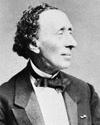- Andersen, Hans Christian
-
died Aug. 4, 1875, CopenhagenDanish writer of fairy tales.Though reared in poverty, he received a university education. In his many collections of tales, published 1835–72, he broke with literary tradition and employed the idioms and constructions of spoken language. His stories are imaginative combinations of universal elements from folk legend and include such favourites as "The Ugly Duckling" and "The Emperor's New Clothes." While some reveal an optimistic belief in the ultimate triumph of goodness and beauty (e.g., "The Snow Queen"), others are deeply pessimistic. Part of what makes his tales compelling is the way they identify with the unfortunate and outcast. He also wrote plays, novels, poems, travel books, and several autobiographies.
 Hans Christian Andersen.The Bettmann Archive
Hans Christian Andersen.The Bettmann Archive* * *
▪ Danish authorborn April 2, 1805, Odense, near Copenhagen, Denmarkdied August 4, 1875, Copenhagenunique master of the fairy tale whose stories are famous throughout the world; he is also the author of plays, novels, poems, travel books, and several autobiographies. While many of these works are almost unknown outside Denmark, his fairy tales (fairy tale) are among the most frequently translated works in all literary history.Andersen was born in a slum and had a difficult battle breaking through the rigid class structure of his time. The first significant help came from Jonas Collin, one of the directors of the Royal Theatre in Copenhagen, to which Andersen had gone as a youth in the vain hope of winning fame as an actor. Collin raised money to send him to school. Although school was an unhappy experience for Andersen because of an unpleasant headmaster, it allowed him to be admitted to the University of Copenhagen in 1828.The next year Andersen produced what is considered his first important literary work, Fodrejse fra Holmens Kanal til Østpynten af Amager i aarene 1828 og 1829 (1829; “A Walk from Holmen's Canal to the East Point of the Island of Amager in the Years 1828 and 1829”), a fantastic tale in the style of the German Romantic writer E.T.A. Hoffmann (Hoffmann, E.T.A.). This work was an immediate success. He then turned to playwriting. After some unsuccessful attempts, he achieved recognition for Mulatten (1840; “The Mulatto”), a play portraying the evils of slavery. The theatre, however, was not to become his field, and for a long time Andersen was regarded primarily as a novelist. Most of his novels are autobiographical; among the best-known are Improvisatoren (1835; The Improvisatore), O.T. (1836; OT: A Danish Romance), and Kun en spillemand (1837; Only a Fiddler).Andersen's first book of tales, Eventyr, fortalte for børn (1835; “Tales, Told for Children”), included stories such as “The Tinderbox,” “Little Claus and Big Claus,” “The Princess and the Pea,” and “Little Ida's Flowers.” Two further installments of stories made up the first volume of Eventyr (1837); a second volume was completed in 1842, and to these was added Billedbog uden billeder (1840; A Picture-book Without Pictures). New collections appeared in 1843, 1847, and 1852. The genre was expanded in Nye eventyr og historier (1858–72; “New Fairy Tales and Stories”).These collections broke new ground in both style and content. A real innovator in his method of telling tales, Andersen used the idioms and constructions of the spoken language, thus breaking with literary tradition. While some of his tales exhibit an optimistic belief in the ultimate triumph of goodness and beauty (e.g., “The Snow Queen”), others are deeply pessimistic and end unhappily. Indeed, one reason for Andersen's great appeal to both children and adults is that he was not afraid of introducing feelings and ideas that were beyond a child's immediate comprehension, yet he remained in touch with the child's perspective. He combined his natural storytelling abilities and great imaginative power with universal elements of folk legend to produce a body of fairy tales that relates to many cultures.It may also be noted that part of what makes some of the tales so compelling is Andersen's identification with the unfortunate and the outcast. A strong autobiographical element runs through his sadder tales; throughout his life he perceived himself as an outsider, and, despite the international recognition he received, he never felt completely accepted. He suffered deeply in some of his closest personal relationships.From 1831 to 1873 Andersen spent a good deal of his time traveling throughout Europe, Asia Minor, and Africa, and his impressions are recorded in a number of travel books, notably, En digters bazar (1842; A Poet's Bazaar), I Sverrig (1851; Pictures of Sweden), and I Spanien (1863; In Spain). Because Andersen rarely destroyed anything he wrote, his diaries and thousands of his letters are extant.Additional ReadingElias Bredsdorff, Hans Christian Andersen: The Story of His Life and Work, 1805–75 (1975, reissued 1994); Bo Grønbech, Hans Christian Andersen (1980); Sven Hakon Rossel (ed.), Hans Christian Andersen: Danish Writer and Citizen of the World (1996); and Jackie Wullschläger, Hans Christian Andersen: The Life of a Storyteller (2000).* * *
Universalium. 2010.
